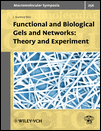Deformation Studies on Polymer-Clay Nanocomposite Gels
Abstract
Summary: The polymer-clay nanocomposite gels (NC gels), developed by Haraguchi et al. (Adv. Mater., 2001), exhibit extraordinarily high mechanical properties, such as high elongations and high ultimate strengths. In order to understand the origin of these properties, contrast-matched small-angle neutron scattering (SANS) studies were carried out for stretched NC gels. It was found that (1) the scattering function for NC gels is simply given by a Lorentz function, a function for semidilute polymer solutions, without a characteristic cross-link inhomogeneity term for polymer gels, and (2) the unique mechanical properties are ascribed to its network structure, i.e., long polymer chains connected by “plane” cross-links.




